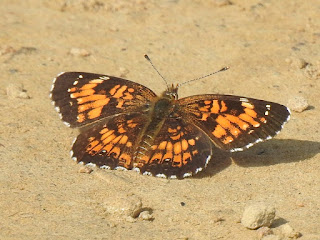NATURE MONCTON INFORMATION LINE, June 29, 2020 (Monday)
To view the photos mentioned in this
edition go to http://nminfoline.blogspot.ca
To respond by email, please address your
message to the information line editor, nelsonpoirier435@gmail.com
Please advise the editor
at nelsonpoirier435@gmail.com if any errors are noted in wording
or photo labelling. Note that corrections, deletions, or delayed additions
may not always appear on the info line and email transcript but will always
appear on the BlogSpot. For this reason, it is recommended that those wishing
to look at historical records use the BlogSpot rather than the email
transcript. The BlogSpot can always be accessed from the website.
For more information on Nature Moncton,
check the website at www.naturemoncton.com
Edited by: Nelson Poirier nelsonpoirier435@gmail.com
Transcript by: David Christie
Info Line #: 506-384-6397 (384-NEWS)
** It is so great to be able to mention Eastern
Bluebirds [Merlebleu de l'Est] every few days. Stella LeBlanc heard, and later
found, a female bluebird in their Bouctouche yard earlier this week. It was
back again on Saturday evening in a lightning storm, but Jean-Paul did Gerta
photo. The nest site is not known but it must be in the area.
** Louise Nichols took a walk behind the Beaubassin
Research Station on Sunday morning. This is located by driving down the
dead-end road past the Irving Big Stop in Aulac but turning to the right
towards the former house, now a Federal Research Station. Louise comments that
it was a very lively area with lots of action. Four species of sparrows were
present, and all vocalizing, being Song [Bruant chanteur], Savannah [Bruant des
pres], Swamp [bruant des marais], and Nelson's [Bruant de Nelson] and got a
great photo of a Nelson’s Sparrow vocalizing.
She also saw a Pied-billed Grebe [Grebe a bed
bigarre ] on a nest in one of the impoundments. The photo shows the adult grebe
beside the nest and a young grebe in it.
Two Common Ravens [Grand Corbeau] fledglings were
in one tree and a parent in a nearby tree. All were calling to each other and
it can be seen in the photo that the young are now adult size, but note the
thickened area at the commissure of the bill that indicates a recently fledged
bird.
Louise also got photos of a Spiny Baskettail
[Epitheque epineuse] dragonfly. Gilles Belliveau very clearly helped us separate
this species from the Beaverpond Baskettail. Gilles' helpful explanation is
attached.
“Actually, the back of the head on Louise’s photo is
black which rules out Beaverpond Baskettail (so do the shape of the
appendages). This is a Spiny Baskettail which is our other common and
widespread Baskettail.
Gilles attachs cropped and edited versions of Louise’s photos to point out the two things he is referring to and also attached photos of what they would look like on a Beaverpond Baskettail.
As you can see in the photos, the shape of the appendages of Beaverpond Baskettail is quite different than those of Spiny Baskettail. Beaverpond Baskettail has the upper appendage thick and straight with a sharp 45 degree (roughly) bend at the end while Spiny has a thinner and longer upper appendage that gently curves down then virtually straightens out at the end with a slight curve up.”
** Cathie Smith reports seeing five Turkey Vultures [Urubu a' tete rouge] perched on fence posts, as they drove across the Harvey Dam pasture area on Saturday. This area, Memramcook and Quispamsis areas, have become hotspots for Turkey Vultures. However, they seem to be getting more frequent everywhere in New Brunswick. They are welcome re-cyclers and it is pleasing to watch their effortless flight-style, using the air currents to support their dihedral flight pattern that ends up in nearly effortless flight.
** Aldo Dorio got another photo of one of our
several syrphid flies', a.k.a. flower flies that imitate wasp species as a
protection measure. They sometimes get the handle hover flies, as many of them
tend to hover.
** Vipers Bug-loss [Viperine vulgaire] is a plant blooming
at the moment. It's an introduced species often seen roadside, as many of our
introduced species are. It's a rather striking flower and an erect plant that
can easily grow to waist height or higher. It tends to prefer alkaline areas
and seems to becoming more common. A few photos of some noted on Sunday are
attached.















No comments:
Post a Comment